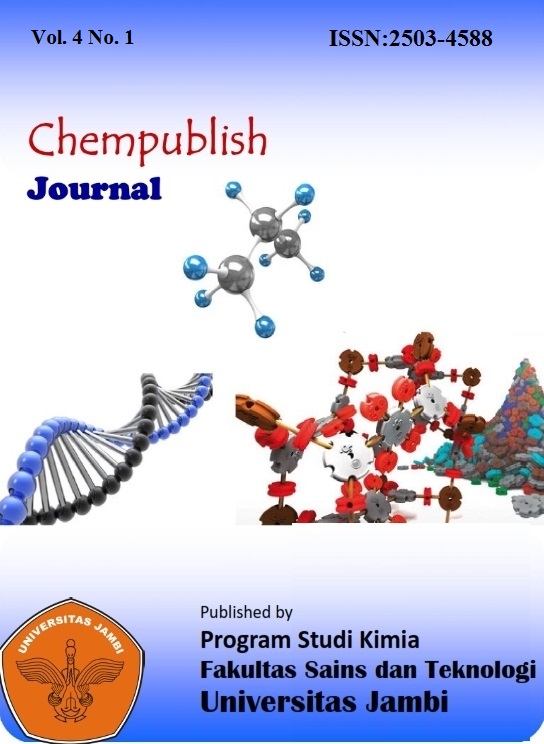The utilization of chicken bone activated carbon as an adsorbent and its implementation in chemistry learning
DOI:
https://doi.org/10.22437/chp.v4i1.6795Keywords:
Bore well water, chicken bone activated carbon, adsorption, Fe metals, AASAbstract
Brownish yellow is one of the characteristics of bore well water which indicates a high concentration of iron (Fe) that will affect human health and damage the aesthetic value. This study aims to purify the bore well water by reducing the concentration of Fe metal by adsorption of chicken bone activated carbon (CBAC) and implementing the results of research on the material of colloidal adsorption properties at Pekanbaru Telkom Vocational High School. CBAC is made through 3 steps namely dehydration at 50oC, carbonization at 400oC and activation with HCl, formic acid and NaOH pa. Each 1 gram of CBAC is mixed with the volume varied by 5; 10; 15; 20 and 25 ml. Measurements of Fe metal concentrations were carried out using Atomic Absorption Spectrophotometer (AAS) and the data obtained were then analyzed descriptively through tables and graphs. Maximum adsorption of CBAC was obtained in 20 ml of bore well water with a percentage reduction 99.92%. All results of treatment meet Fe metal quality standards as stipulated in Republic of Indonesia Minister of Health Regulation No. 416 of 1990. Analysis of student response questionnaires based on questionnaire analysis techniques obtained a cumulative value of 88.62% (very good).
Downloads
References
Departemen Kesehatan RI. 1990. Peraturan Menteri Kesehatan RI No.416/MenKes/Per/IX/1990, Depkes RI, Jakarta
Hawigyo. 2001. Cara Mendapatkan Air Bersih, PT Balai Pustaka, Jakarta.
Handayani, Ardha, Subardi B. dan Itnawita. 2015. Potensi Arang Aktif dari Tulang Kerbau sebagai Adsorben Ion Besi, Timbal, Sulfat dan Klorida dalam Larutan. Jurnal Online Mahasiswa Fakultas Matematika dan Ilmu Pengetahuan Alam Universitas Riau. 1: 47-55.
Maftuhin, T.A. Hanifah dan S. Anita. 2014. Potensi Pemanfaatan Tulang Ayam sebagai Adsorben Kation Timbal dalam Larutan. Jurnal Fakultas Matematika dan Ilmu Pengetahuan Alam Universitas Riau.
Nuroso. 2011. Panen Ayam Pedaging dengan Produksi 2 x Lipat, Penebar Swadaya, Jakarta.
Sa’adah, Naily’s, Rum H. dan Nor B. A. P. 2013. Pengaruh Asam Formiat pada Bulu Ayam sebagai Adsorben terhadap Penurunan Kadar Larutan Zat Warna Tekstil Remazol Golden Yellow RNL. Jurnal Fakultas Sains dan Matematika Universitas Diponegoro. 1 (1): 202-209.
Slamet, J. S. 2001. Kesehatan Lingkungan. Gajah Mada University Press, Yogyakarta.
Sujadi, F. 2008. Air Bersih Sumber Kehidupan Sehat, Rineka Cipta, Jakarta.
Warlina, L. 2004. Pencemaran Air: Sumber, Dampak dan Penanggulangannya, Sekolah Pascasarjana Institut Pertanian Bogor, Bogor.
Downloads
Published
Versions
- 2019-07-19 (1)
- 2019-07-19 (1)






